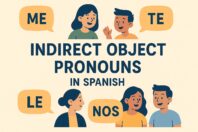Conmigo and Contigo: Meaning, Usage, and Examples

Get our free email course, Shortcut to Conversational.
Have conversations faster, understand people when they speak fast, and other tested tips to learn faster.
More infoWhether you’ve been reading or watching videos in Spanish, we’re sure you’ve come across the words conmigo and contigo. These two words belong to a category of pronouns in Spanish known as prepositional pronouns.
Today’s post will be short and sweet. We’ll show how to use conmigo and contigo in Spanish, and we’ll go into contigo and conmigo meanings. As we do with all of our lessons, we’ll include lots of examples to help make everything clear for you.
Without further ado, let’s get started!
Contigo and Conmigo Meaning and Uses
Contigo and conmigo mean that someone is doing something alongside someone else. Conmigo is translated as with me, and contigo is translated as with you.
- Do you want to come with me to the cinema tonight? – ¿Quieres venir conmigo al cine esta noche?
- With you, I’ll go to infinity and beyond. – Contigo voy al infinito y más allá.
- I never feel alone when I’m with you. – Nunca me siento sola cuando estoy contigo.
- You cannot get bored with me, I can assure you that. – Conmigo no te puedes aburrir, te lo aseguro.
Contigo and conmigo are a combination of the preposition con, meaning with, and the prepositional pronouns mí and ti.
We can also use the preposition con + any other prepositional pronoun, but they are not connected as one word. For instance, we can say con él, con ustedes, or con ellas, meaning with him, with you, or with them. However, we don’t say “con mí” or “con ti.” Instead, the correct forms for these word pairs are conmigo and contigo. Likewise, we don’t separate these two to say “con migo” or “con tigo.”
In short, while any other prepositional phrases in Spanish that start with the preposition con are made up of two words, in Spanish conmigo and contigo are always written as one word.
To learn other prepositions in Spanish, such as “next to,” “in front of,” or “behind,” check out our related post on Spanish prepositions.
Contigo and Conmigo used reflexively
The pronouns conmigo and contigo can also function reflexively in a sentence. That is, they can refer to the person who is performing the action.
- I love spending time with myself reading books. – Me encanta pasar tiempo conmigo leyendo libros.
- Why do you speak to yourself when you’re in front of the mirror? – ¿Por qué hablas contigo mismo cuando te miras al espejo?
Note that, grammatically, this use is different than reflexive pronouns, since in this case the mí and ti are still being used as prepositional pronouns in combination with con. When we say “reflexively” here, we’re referring to the fact that the action is nonetheless being directed at the same person who is carrying out the action.
Contigo formal or informal?
Contigo refers to the personal pronoun tú, so contigo should be used when you are addressing someone informally. That is, a friend or someone you know well, or where there’s no need to show respect.
- Do you have the house keys with you? – ¿Tienes las llaves de la casa contigo?
- Honey, I want to be with you for ever. – Amorcito, quiero estar siempre contigo.
- My friend, I think Mario always wants to dance with you. – Amiga, pienso que Mario siempre quiere bailar contigo.
If you need to be more formal, like when you speak to your boss or to someone you don’t know, con usted is the phrase that you’ll need.
- Boss, I need to speak with you now, please. – Jefe, necesito hablar con usted ahora, por favor.
- Ma’am, I have to share this information with you. – Señorita, tengo que compartir esta información con usted.
- I’d like to schedule a meeting with you for next week. – Me gustaría programar una reunión con usted para la próxima semana.
See our post on tú vs usted to review when to use which singular you in Spanish.
Sin ti and sin mí
For expressing the opposite meaning of contigo and conmigo in Spanish, we use the preposition sin, meaning without. The interesting thing with this is that in the negative form, we use the simple ti and mí pronouns, and not ‑migo or ‑tigo. In other words, to say without me we say sin mí, and for without you we say sin ti.
- You can go without me to the party, you’re old enough. – Puedes ir sin mí a la fiesta, ya eres lo suficientemente mayor.
- Traveling without you was weird. – Fue raro viajar sin ti.
Conclusion
Today we’ve seen that contigo and conmigo, meaning with you and with me, are single-word combinations of the preposition con and the prepositional pronouns tí and mi. Used reflexively, contigo and conmigo can also be translated as with yourself and with myself.
We also learned that contigo may be only used in informal situations or with people you know very well, with con usted being the correct option when addressing anyone formally. In addition, we pointed out that the opposites of contigo and conmigo are sin ti and sin mí, meaning without you and without me.
Now you have all the information you need to correctly use and understand contigo and conmigo in Spanish. The next time someone speaks with you in Spanish using these pronouns, you’ll understand them! – ¡La próxima vez que alguien hable contigo usando estos pronombres los entenderás!



